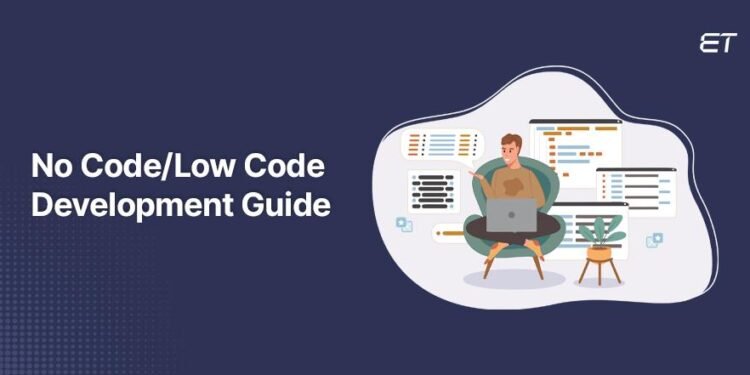No-code and low-code development are changing the game for frontend services. These methods let businesses build and launch apps quickly, even if they need to gain many coding skills. This is a big deal because it means more people can create and improve web applications.
Companies can save time and money, and anyone with a good idea can get involved. This approach helps businesses be competitive and adapt to new challenges quickly. A custom web app development company can use these tools to speed up their processes and deliver better results. Using no-code and low-code development is smart for any business wanting to stay ahead in today’s tech-driven world.
What is No Code/Low Code Development?
No-code and low-code platforms are tools that simplify app creation. No-code platforms allow users to build apps using visual interfaces and drag-and-drop features without writing code. Low-code platforms also provide visual tools but may require basic coding for advanced features.
The main difference is the level of coding required. No-code is entirely code-free, while low-code involves minimal coding. Both platforms create various applications, from simple websites to complex business tools.
Common use cases include building business apps, automating workflows, and quickly creating custom web apps. The benefits are clear: these platforms speed development, reduce costs and make app building accessible to non-developers. This is especially useful for a custom web app development company, as it can deliver projects faster and more efficiently.
Advantages of No Code/Low Code Development
No-code and low-code development offer several key advantages.
- First, they provide speed, allowing for much faster development times than traditional coding. This is crucial for companies needing quick solutions.
- Second, these platforms increase accessibility. They empower non-developers to build applications, which means more people in a company can contribute to app creation.
- Third, they are cost-effective. No-code and low-code tools reduce both development and maintenance costs. Businesses save money by cutting down on the need for extensive coding and ongoing support.
- Lastly, these platforms offer flexibility. They allow businesses to adapt to changing needs, updating or creating new apps as requirements evolve. This flexibility benefits any company providing frontend services or a custom web app development company.
Common Misconceptions About No Code/Low Code
Many people have concerns about no-code and low-code development. Here are some common misconceptions and the truth behind them:
● Scalability Concerns: People often think no-code and low-code platforms can’t handle large, complex projects. Modern platforms are designed to scale with business needs, making them suitable for both small and large applications in frontend services.
● Security and Compliance: Some believe no-code and low-code apps aren’t as secure as traditional apps. However, reputable platforms offer robust security features and comply with industry standards.
● Role of Professional Developers: There is a misconception that professional developers are no longer needed. In reality, developers are essential for customization and complex integrations. These platforms increase developer productivity by handling repetitive tasks. This allows developers to focus on complex challenges.
Addressing these misconceptions can help a custom web app development company and frontend services provider effectively utilize no-code and low-code tools to deliver high-quality solutions.
How to Choose the Right Platform

When choosing a no-code or low-code platform, several key factors should be considered:
- Ease of Use: The platform should be intuitive and accessible to non-developers.
- Scalability: Ensure the platform can grow with your business requirements, particularly in frontend services.
- Integration Capabilities: The platform should easily connect with other systems and tools.
- Support: Reliable customer service and resources are crucial.
Popular no-code/low-code platforms include:
- OutSystems: Known for its enterprise capabilities and scalability.
- Mendix: Offers strong integration features and a user-friendly interface.
- Bubble: Ideal for startups and smaller projects due to its ease of use.
Tips for selecting the best platform:
● Assess Business Requirements: Understand what your business needs from the platform.
● Evaluate Project Complexity: Choose a platform that can handle the complexity of your projects.
● Consider Team Skill Level: Ensure the platform matches the technical expertise of your team.
With the right platform, frontend services provider and a custom web app development company can improve their capabilities and deliver superior solutions.
Examples of No Code/Low Code Success
No-code and low-code platforms have changed many businesses. Here are a few examples and scenarios:
- Retail Company: A retail business used a no-code platform to create a customer feedback app in just a few days. This quick deployment improved their customer service and increased satisfaction.
- Financial Services: A financial services firm used low-code tools to automate its internal processes, resulting in faster workflows and reduced operational costs.
- Healthcare Provider: A healthcare provider utilized a low-code platform to develop a patient management system. This system streamlined operations and improved patient care.
- E-commerce Startup: An e-commerce startup built its online store using a no-code platform. This allowed them to launch quickly and scale their business efficiently.
Embrace No-Code/Low-Code for Better Frontend Services
No-code and low-code platforms are changing how businesses handle frontend services. They make app development faster, easier, and more affordable. These tools help companies innovate and adapt quickly, staying ahead in a fast-paced market.
Now is the perfect time to explore no-code and low-code solutions. See how they can benefit your business. For more complex projects, get help from experts. Contact a trusted custom web app development company today to start improving your frontend services.












